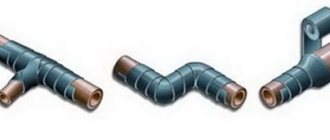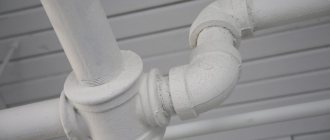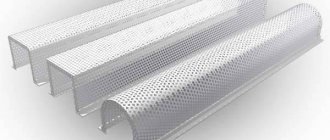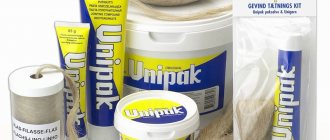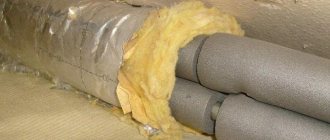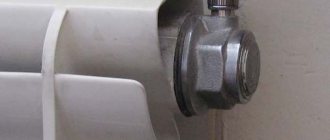Why is sewer pipe sealing necessary?
The need for proper installation of the sewer system is obvious. Firstly, this will increase the service life of the pipes, secondly, it will reduce the risk of leaks, including from too much wastewater pressure, and thirdly, it will not allow unpleasant odors to penetrate into the room. In addition, due to sealing, the pipes are protected from the entry of water from the outside, be it precipitation or groundwater, as well as from too large a temperature difference between the environment and the water flowing inside.
Which sealant is best for sewer pipes
What is sealant for sewer cast iron pipes and how to choose the right material for sealing joints? One of the main tasks facing the master at the final stage of construction is to prevent leaks that appear in the sewer system.
Sealant for sewer pipes is a special composition that protects joints from leakage. In addition, it provides ease of installation and helps cope with emergency situations. In this article we will look at what types of sealing substances there are for PVC pipes and cast iron channels.
Main types of sealing materials (characteristics)
Previously, oil paint and plumbing linen were used as sealing materials. But modern technologies offer a much wider selection of different sealing materials.
Sealing tapes
These are self-adhesive tapes, somewhat similar to a roll of white tape. They can have different widths and are mainly used for plastic pipes in residential areas. Such tapes not only protect against water leakage, but also help strengthen various related elements such as plugs, joints, and so on.
The main advantages of this sealant include the following: lack of electrical conductivity, reduced risk of corrosion of sewer pipes, ease of use and at the same time a high level of reliability of the material.
Example of sealing tape
It is important to remember that such tapes quickly deteriorate when exposed to ultraviolet rays, which is why they are recommended for use only inside residential premises. However, if there is still a need to use it in the sun, then the tape is covered from it, for example, with a special protective film.
In order for this material to have the intended effect, the pipes must be cleaned of dust and dirt, and then thoroughly wiped or dried. Immediately before gluing the tape, a primer is applied. After this, the tape is wrapped around the pipe in a spiral, tightly, without folds, with a half overlap.
Polymer sealants
Otherwise known as silicone, since the main material in this case is silicone rubber. They are considered one of the most popular sealing agents, including because, if desired, you can choose such a material of any color, including the same as that of the sewer pipe. They are mainly used to strengthen joints and seal fistulas. They can have both neutral and acidic compositions. Acid options are cheaper, but some pipes are not resistant to acids, and in general such compositions are not recommended for use on fragile elements. Neutral options are used in all cases where acidic options cannot be used.
Among the advantages of this type of product are the following: when used, mold and rot do not appear, even over time; when hardened, the composition becomes like rubber and perfectly protects sewer pipes from leaks. In addition, silicone sealants adhere well to the pipe material, they are durable, resistant to moisture and temperature changes, and also last quite a long time.
Polymer sealant for sewer pipes
The sealant is squeezed out with a special gun for installation, however, if you don’t have one at hand, you can use an ordinary hammer.
Mastics based on petroleum products
Also good for sealing sewer pipes, especially for filling sockets. There are several main varieties: bitumen-polymer, bitumen-talc, bitumen-rubber, bitumen-asbestos-polymer. Mastics come in both cold and hot application methods. Those with a cold method are a little more expensive, but they are simple and safe to use. Before using such products, it is advisable to turn off the water supply, and the pipes themselves must be cleaned, degreased and dried.
Epoxy resin
This variety is often used at home. In essence, resin is a universal glue. Before use, it is mixed with a special hardener. The required mixing proportions are indicated on the packaging by the epoxy resin manufacturer. By the way, you cannot deviate from the specified proportions; this can lead to unexpected and unpleasant consequences. From the mixture suddenly boiling, to the resin's lack of effectiveness as a sealant for sewer pipes.
Portland cement
It is a dry mixture of gypsum, clinker and calcium silicates with special additives to increase the reliability of sealing. Before use, the composition is diluted with water to a thick solution. The resulting slurry must be used immediately, as it hardens quite quickly (from 5 to 10 minutes) and turns into a monolithic structure with frost resistance, high strength, and the ability to repel water.
Advantages and disadvantages
The advantages include the following qualities:
- Moisture and frost resistance, which allows the mixture to be used, including for external pipes;
- High strength and reliability of the hardened mortar;
Portland cement is one of the sealants for sewer pipes.
And as a disadvantage, it is worth noting the fact that it is necessary to work with the diluted mixture very quickly, otherwise it will harden and will be useless.
How to seal sewer pipes?
Sealing of sewerage systems in modern construction conditions is also carried out by other types of materials. Craftsmen often use epoxy resin, asphalt mastic, resin strands, hemp ropes and technical sulfur.
Most often, when working at home, epoxy resin is used. To harden this material, polyethylene polyamine is used for cold hardening, and maleic anhydride is used for hot hardening. But others can also be used. The combination proportion can vary and on average varies from 10:1 to 5:1.
Technical sulfur is used to seal sewer outlets. To do this, it is crushed, heated to a suitable plastic state and poured directly onto the inner surface of the joints of the exhaust pipes. This compound is made from Portland cement, in this case you need to prepare a solution.
Soundproofing of sewer pipes
Tarred hemp rope is excellent for working with ceramics and cast iron. And the filling of petroleum bitumen and asphalt mastic well seals the joints of ceramic pipes.
Technology and rules for applying sealant
There is a specific set of steps that must be performed regardless of the material used for sealing.
So, first, the pipes need to be cleared of blockages, as well as small foreign particles, if any are found. And then thoroughly dry, clean and degrease the work surface. Only then is any sealant applied. And then the mixture is allowed to dry for the required time. While the substance dries, the sewer cannot be used.
When installing a cast iron sewer system, one of the pipes is inserted into the other, and the resulting joint is filled with a sealing substance. Often, before sealing, tow (otherwise called plumbing flax) is inserted into the resulting gap and sealed. Then the joint is covered with Portland cement diluted with water in a ratio of 9:1.
Cement is often diluted with asbestos fiber in a 2:1 ratio. Immediately before use, add a little water to this mixture. Instead of cement, the most common sealant for PVC sewer pipes or for cast iron structures is also suitable.
After sealing, it is recommended to cover the area with a damp cloth or polyethylene to prevent the cement from drying out too quickly.
In some cases, it may be necessary to partially replace the sewer system, as a result of which it will be necessary to seal the joints between cast iron and plastic pipes. To successfully solve this problem, you will first need to purchase special adapters for connecting metal and plastic pipes. The cast iron pipe must be degreased and cleaned. Then the inner and outer parts of the socket are coated with sealant. The next step is to insert the purchased adapter into the socket and now you need to wait until the sealant dries. When the substance has dried, the pipes are connected to each other. The resulting system must be checked for leaks.
Sealing cast iron sewer pipes
To connect cast iron riser pipes, another is inserted into the socket of one pipe, and the joint is sealed with the selected material. Experienced craftsmen usually carry out everything using the following technology:
- Linen tow is inserted into the gap between the riser pipes without impregnation to a depth of approximately 2/3 and caulked (compacted).
For your information! Flax tow can be replaced with hemp treated with resin.
- On top of the tow, in the free space of the joint, a mixture of water and Portland cement is placed in a combination of 1:9, respectively.
For your information! To create a mixture, if necessary, you can use cement in combination with asbestos fiber, in a 2:1 combination, respectively. And before pouring it into the pipe, add a little water to the mixture.
All of the above materials can be replaced with silicone sealant, which is simply poured into the free space between the riser pipes. And to protect this type of sealant from drying out too quickly, the application area is covered with polyethylene or a damp cloth.
Popular brands of sealants (brief product characteristics)
The modern market offers simply a huge selection of different sealing materials. The Ceresit and Moment brands are rightfully considered the highest quality and most popular. It is the compositions from these manufacturers that are recommended to be purchased and used, if possible. But besides them, there are other brands.
Ciki Fix
A brand of sealants that are great for ceramic and metal sewer pipes. The composition is colorless, so the owner does not have to worry about the design being damaged. After drying, this mixture hardens and becomes resistant to various solvents and detergents. It has excellent adhesive properties, thanks to which it is able to firmly adhere to various surfaces. This waterproof and elastic mixture does not deteriorate over time, even if it was used outdoors and not indoors.
Ciki Fix sealant for sewer pipes
By the way, the products of this brand do not have sanitary properties, so they are not recommended for use in rooms with poor ventilation, in order to avoid the appearance of rot and mold on sewer pipes.
Belinka
Compositions consisting of one component - silicone rubber. The sealants of this brand are similar to a thick paste that can harden from moisture in the external environment. Used to repair or strengthen seams and joints of the sewerage system. They have good elasticity and high strength. Also, the products of this brand, after drying, are able to resist the adverse effects of the external environment, such as snow, rain, too bright sun or sea water. And, in addition, it is practically not susceptible to the harmful effects of various chemical solutions.
When strengthening vertical joints, this type of sealant does not slip, which greatly simplifies working with them. The drying time of the composition varies depending on the applied layer, ambient temperature and humidity. Until the composition has hardened, it can be removed somehow with a solvent or detergent. If the mixture has dried, then only a mechanical removal method is suitable.
Tytan
Specializes in the production of sanitary-type silicone sealants. In each type of product of this brand you can find various additives that prevent the appearance of fungus and mold. To give the joints particularly high strength, it is recommended to use a compound marked Professional. After drying, the composition is practically unaffected by various detergents and cleaning agents. It is also important that the color of the applied composition does not change over time.
Dow Corning
Their products can often be used as glue. Dow Corning brand products have a thick consistency and are also able to penetrate deeply into even the smallest gaps, while simultaneously strengthening seams and joints. The compositions of this brand can easily withstand temperature changes, since their normal operation range starts from -65 degrees and ends at 260 (usually this indicator for sealants is limited to 180 degrees). However, the substance can withstand short-term loads and temperatures up to 315 degrees. This type will be useful if you need to create something elastic and heat-resistant.
Dow Corning Sealant for Sewer Pipe
Dow Corning sealants have a paste consistency. They do not drip when applied, are resistant to gasoline and oil, and are often used as glue. Most often, such compositions are used for industrial needs.
Krass
This brand produces sealing substances consisting of one component. After hardening of this composition, high-strength seams are obtained that do not change color and do not shrink over time. The substance is universal and is considered the most resistant to fire among all those described above. Krass brand products are well suited for sealing plastic or ceramic pipes (but not cast iron), dry quickly, and when dry form strong but elastic joints. Thanks to this, the entire structure can easily withstand even too large seam deformations. Sealing agents of this brand can be used both indoors and outdoors.
Types of sealants and their application
The most common materials for sealing, which ensure high-quality work with the components of the sewer system, are tapes, silicone materials, technical sulfur, Portland cement solution, epoxy resin, resin strand, asphalt bitumen, etc. When using each of them, it is necessary to follow a certain technology in order to achieve required quality.
Option #1 - self-adhesive tapes
Among modern materials for sealing, special tapes with anti-corrosion properties are widely used. They are used to seal the area where pipes of different types are connected, to protect taps, plugs, bends, turning corners and other elements of the sewer system.
Sealant tapes are quite simple to use, but very reliable and effective for protecting pipe joints
The composition of such a tape includes a copper or aluminum layer, its base is bitumen-rubber. The protective film is removed during installation. Self-adhesive sealant tape is easy to use but very effective, strong and durable. It not only seals, but also provides comprehensive pipe protection, including anti-corrosion and dielectric protection.
Sealing of sewer pipes using tape is carried out in the following order:
- Before applying the tape, the surface is cleaned of dust and dried;
- to avoid wrinkles and folds, the tape is kept taut when winding;
- The tape is applied in a spiral with a 50% overlap, so the entire insulated surface will be covered with 2 layers of film.
It is important to know! Sealing tapes do not withstand direct exposure to ultraviolet radiation, so sealed sections of sewer pipes located in the open sun must be wrapped with additional protective material.
Option #2 - silicone sealing materials
The basis of such sealants is silicone rubber. The composition of silicone sealants is a complex mixture of various substances that provide reliable sealing quality. They are characterized by a high degree of adhesion to surfaces, without pre-treatment with primers.
A distinctive feature of silicone sealants is a high degree of adhesion to surfaces that do not require additional processing
Depending on the type of hardener, silicone sealant can be of two types:
- Acid. It has a relatively low cost, but is not suitable for application to surfaces that can interact with acids.
- Neutral. This sealant is considered more universal and is suitable for any surface.
Silicone sealants are used to seal joints between metal and plastic pipes. With the participation of moisture in the air, vulcanization of the silicone sealant occurs. Silicone paste turns into a rubber-like substance after vulcanization.
Types of sealants
Sealing of sewer pipes can be done with the following materials:
- reinforced aluminum adhesive tapes;
- silicone sealants;
- mastics from various manufacturers;
- polymer cement solutions;
- sanitary winding;
- epoxy resin;
- technical sulfur.
To choose the right sealant for sewer pipes, you need to know the material from which the drain is made. Silicone compounds and reinforced tapes are suitable for lightweight plastic pipes PVC, PEX, HDPE, etc. If you have to work with metal (steel or cast iron), you need to use something serious. It is also important to consider for what work the solution is purchased.
The joints of PVC plastic pipes are sealed with lightweight silicone, which is unlikely to cope with an emergency leaking sewer. It is also important to follow the instructions. It describes the optimal conditions under which sewer pipes should be sealed. For example, let's take the optimal conditions for curing silicone sealant (this is room temperature, at which it dries for about 4 minutes). When working in cold weather, the hardening time is significantly longer.
There is a need to purchase another type of sealant - frost-resistant silicone. We'll talk about the nuances of using different materials below.
